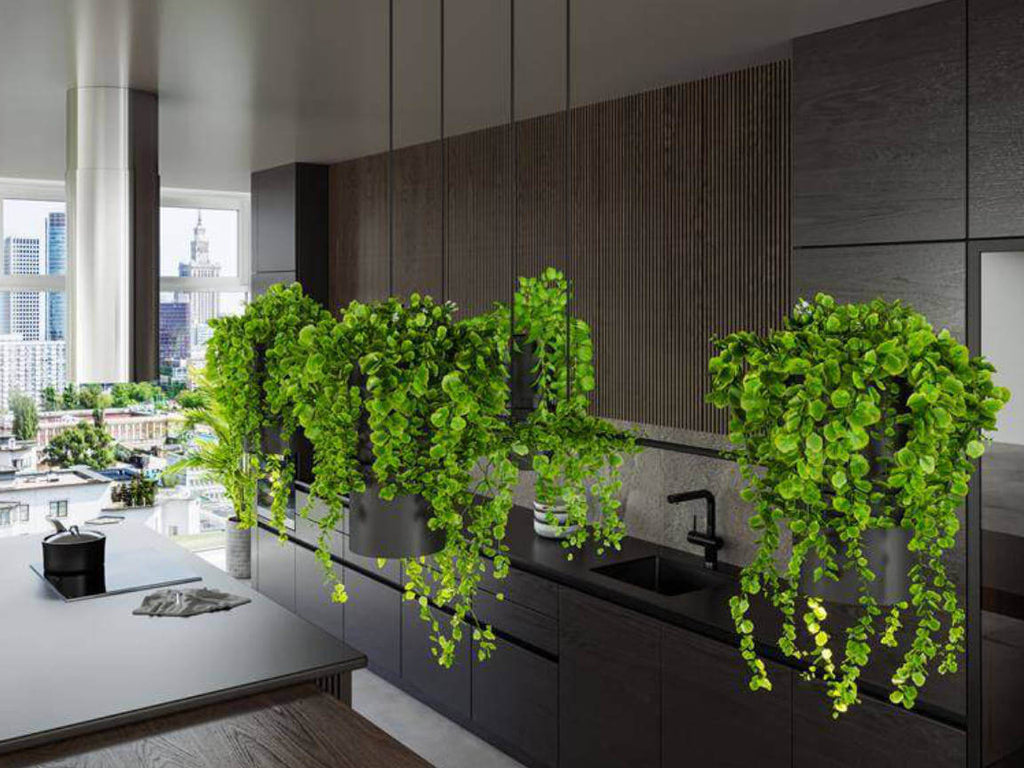Table of Contents
What is Biophilic Lighting
To understand biophilic lighting, first, we have to understand biophilia. Biophilia as a concept was first popularised by the biologist E.O Wilson in his 1984 novel of the same name, where he defined it as the human’s “inherent affinity and attraction towards living systems and the natural world”. He then went on to say that this instinctive connection that humans have with nature is extremely important for both our health and wellbeing, and how spending time in nature can have natural, restorative benefits for humans. In the modern day, biophilia creeps into our homes in many different ways – whether it be having plants indoors, opting for natural materials, or having large, open windows that allow plenty of natural light.
One great way of integrating biophilia into your home is through biophilic lighting. Through opting for lighting that emphasises patterns, materials and intensities that are commonly found within the natural world, it’s easy to create an environment that instantly feels more calming and relaxing. Plus, it’s scientifically proven that making changes like these can bring multifaceted benefits to your life. Biophilic lighting is gaining recognition as a powerful tool in architectural and interior design, fostering environments that harmoniously blend human needs with the beauty and vitality of nature.
Tenets Of Biophilic Lighting
One of the core ideas behind biophilic lighting is blending the indoors and the outdoors, to make a relaxing space that satisfies our intrinsic need to connect with nature and the outside world. By incorporating some of the following biophilic lighting strategies, you can make a space that’s more inviting, soothing and conducive to healthy human well-being.
Bring The Outdoors In: Mimic Patterns Found in Nature
- One of the many ways that Biophilic Lighting makes a strong connection with nature is to incorporate a range of features that mimic elements in the natural world. One of the most prominent and well-known designers that specialise in this type of design is David Trubridge, a New Zealand-based designer who specialises in using sustainable materials to create light fittings that merge both the inside and outside world. Trubridge’s pieces are inspired by the beautiful, often-unnoticed shapes that surround us in everyday nature, and by incorporating natural shapes, patterns and materials, he creates furniture that blends the inside and outside world.
- One of the many ways that Biophilic lighting makes a strong connection with nature is to incorporate a range of features that mimic elements in the natural world. One of the most prominent and well-known designers that specialise in this type of design is David Trubridge, a New Zealand-based designer who specialises in using sustainable materials to create light fittings that merge both the inside and outside world. One great example of his work is the piece ‘Coral’, which takes inspiration from the unique patterns found in coral reefs to create a shade that casts a unique shade of light over any room.
Organic Shapes
- Biophilic lighting makes excellent use of the irregular, fluid and unique shapes and forms that are found outside within nature. By adopting these unique shapes when designing lighting fixtures, designers can create and allude to a range of natural elements, such as flowing water, plant leaves or other natural forms. By doing this, the fittings become an aesthetic centrepiece of any room, drawing attention and creating a calming and natural atmosphere, as it mimics the soothing, non-linear nature of nature itself.
Materials & Textures
- Another excellent way of creating an immersive, natural and relaxing environment is opting for a range of materials and textures that are found within nature. When used in lighting fixtures, organic materials can create a warm, natural and grounded atmosphere within any room. Additionally, choosing textures that are found in nature can bring a unique touch to any fixture, with patterns such as tree bark being popular choices. By integrating materials and textures inspired by nature, biophilic lighting elevates the ambiance of indoor spaces, fostering a greater sense of well-being and harmony with the environment.

Why Biophilic Lighting?
There are several reasons why biophilic lighting is a great choice, in any room or any household. It has been scientifically proven that these natural textures, touches and materials can bring a whole host of benefits to both mood and health. Additionally, they make for a very unique aesthetic touch, and their versatility means that they can be used in a wide range of styled rooms.
Feel Closer to Nature
As E.O Wilson found in his book, humans have an inexplicably innate affinity for nature, and incorporating biophilic lighting helps to satisfy this desire for the natural and bring a variety of benefits and boosts to general well-being.
Aesthetic Appeal
The shapes, patterns and designs found in biophilic lighting fixtures help to bring a unique and natural touch into any indoor space. What would normally be a simple accessory to a room becomes an inviting and appealing centrepiece, as they evoke the beauty and tranquillity of nature. Additionally, the wide variety of designs and styles ensure that there’s always a biophilic lighting fixture that will suit any style of room.
Stabilise Mood
It has been scientifically proven in studies that aspects of biophilic design can improve cognitive function, foster creativity and even lower blood pressure and stress. Through incorporating aspects of nature into the home, you can reap several of the benefits of spending time in nature whilst in the comfort of your own home. When combined with other aspects of biophilic design (e.g. indoor plants, other greenery and plenty of natural light) you can create a homely and welcoming space that’ll boost both your mood and your wellbeing.
Add and explore new ways to decorate you interior. Shop Biophilic Lighting today.




